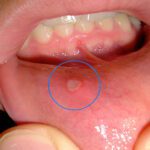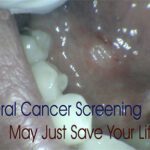
Oral cancer screening is a routine part of a dental examination. Regular check-ups, including an examination of the entire mouth, are essential in the early detection of cancerous and pre-cancerous conditions. Oral cancer is a devastating, even deadly, cancer that can go unnoticed until it has progressed to later stages. It is important to remember that your doctor does not necessarily think you have cancer if he or she suggests a screening test. Screening tests are given when you have no cancer symptoms.
-
Oral cancer effects estimated 35,000 Americans each year, and more than 25% (8000) will die of the disease.
-
In U.S.; one person dies from oral cancer every hour
-
Approximately, only half of those diagnosed with the disease will survive more than five years; because seventy percent of oral cancer cases are diagnosed at a late stage
-
There has been a nearly five-fold increase in incidence in oral cancer patients under age 40, many with no known risk factor
-
The incidence of oral cancer in women has increased significantly. In 1950 the male to female ratio was 6:1: by 2002 it was 2:1
-
African-Americans are especially vulnerable; the incidence rate is 1/3 higher than whites and the mortality rate is almost twice as high
-
Although the use of tobacco and alcohol increase the risk of oral cancer, approximately 25% of oral cancer patients have no known risk factors
As with any cancer, early detection and diagnosis is key; it’s important for patients to see an oral healthcare professional regularly, particularly if they are in the high-risk groups — those who use tobacco, abuse alcohol or have been exposed to HPV.
The Importance of Early Detection
It is now easier than ever to detect oral cancer early, when the opportunity for a cure is great. Your dentist has the skills and tools to ensure that early signs of cancer and pre-cancerous conditions are identified. You and your dentist can fight and win the battle against oral cancer. Know the early signs and see your dentist regularly.
Oral cancer is a disease in which malignant (cancer) cells form in the lips, oral cavity (the tongue, gums, cheeks, floor of the mouth, roof of the mouth), or oropharynx (throat and tonsils). Oral cancer is an abnormal growth of cells in any one of these sites and has the potential to spread to other areas of the body.
How does your dentist perform oral cancer screening:
-
Flat or raised red or white spots or a small sore that are painless. Some are harmless and benign, some are cancerous and others are pre-cancerous, meaning they can develop into cancer if not detected early and removed. (American Cancer Society)
-
Finding and removing epithelial dysplasias before they become cancer can be one of the most effective methods for reducing the incidence of cancer.
-
Fluorescence staining: A procedure in which lesions in the mouth are viewed using a special light. After the patient uses a fluorescent mouth rinse, normal tissue looks different from abnormal tissue when seen under the light.
-
Toluidine blue stain: A procedure in which lesions in the mouth are coated with a blue dye. Areas that stain darker are more likely to be cancer or become cancer.
-
Exfoliative cytology: A procedure to collect cells from the lip or oral cavity. A piece of cotton, a brush, or a small wooden stick is used to gently scrape cells from the lips, tongue, mouth, or throat. The cells are viewed under a microscope to find out if they are abnormal.
-
Brush biopsy: The removal of cells using a brush that is designed to collect cells from all layers of a lesion. The cells are viewed under a microscope to find out if they are abnormal.
What are the treatment options for oral cancer?
Early detection can significantly minimize the amount of treatment needed. Treatment for early-stage oral cancer usually involves surgical resection of the diseased tissue. If the cancerous tissue is large, surgery to remove the diseased tissue may involve removing a large portion of the tongue, lower jaw or throat. When the disease metastasizes, or spreads, to other areas of the body, chemotherapy and/or radiation are required in addition to surgical removal of the diseased tissue.
By: Ladan Zinati

sbesi5u Gum Disease Treatment - Guitar Forum DailyGuitar.com
June 21, 2012[…] Go take a look at this neat link: Cosmetic Dentistry […]